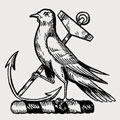Twelve dinner plates from Admiral Lord Bridport’s seagoing silver service, 1785-7
£32,000.00
YEAR OF MANUFACTURE: 1785
ORIGIN: London, England
MAKER: Andrew Fogelberg & Stephen Gilbert
WEIGHT: 199.33 troy ounces (218.70 ounces or 6,200.00 grams)
STOCK CODE: mdwoa
Featured Crests

Item Description
Each of these twelve George III circular silver dinner plates, by Andrew Fogelberg & Stephen Gilbert, London 1785-7, has a shaped and gadrooned rim. Seven plates are dated 1785 with incuse duty marks and five plates are dated 1787. The set was later engraved, between 1794 and 1800, with the heraldic family crest of Hood for Admiral Alexander Hood, first Baron Bridport K.B., later Viscount Bridport, within a garter inscribed Tria Juncta in Uno for the Order of the Bath, surmounted by a baron’s coronet.
Alexander Hood, Viscount Bridport (1726-1814) entered the Royal Navy in 1741, a few weeks before his elder brother Samuel, later Admiral Viscount Hood (1724- 1816). Made post captain in 1756, Hood served through the Seven Years War commanding Minerva, 32 guns,at the Battle of Quiberon Bay on 20 November 1759. In 1761, Minerva joined the squadron which escorted Princess Charlotte of Mecklenburg to England for her marriage to King George III. In a further sign of royal favour, Hood was then given command of the royal yacht Katherine III. In 1780, he was made rear-admiral and, with peace, turned his attention to politics as member of parliament for Bridgwater in Somerset. In 1782, he joined the relief of Gibraltar in Queen, 90 guns. On 7 May 1788 he was made Knight of the Bath and, with the outbreak of war with France in 1793, hoisted his flag in Royal George, 100 guns. In April 1794, Hood was made admiral shortly before he fought at the Battle of the First of June for which he received a naval gold medal and was created Baron Bridport in the Irish peerage (matched in the British peerage two years later). In 1796, Bridport was placed in command of the Channel Fleet in which position he was soon thrust into the Spithead Mutiny when he adopted a sympathetic approach to the seamen’s grievances, earning their gratitude and respect. Until April 1800 Bridport maintained the blockade of Brest with never less than 28 warships, a highly complex and stressful task which, now in his seventies and after nearly sixty years of service, took a heavy toll on his health. Made Viscount Bridport in 1801, he retired to Cricket St Thomas, his home in Somerset, where he died in 1814. On his death, Bridport’s viscountcy lapsed, but he was succeeded as second Baron Bridport by his great nephew Samuel Hood, who married Charlotte Mary Nelson (1787-1873), only daughter of first Earl Nelson and niece of Admiral Viscount Nelson.
Admiral Lord Bridport’s set of silver plates was decorated following his introduction to the Order of the Bath in 1794, but before his elevation in the peerage as Viscount Bridport in 1800. Of plain design with rope- like gadrooned borders – a pattern popular among naval officers, including Admiral Viscount Nelson – the service was designed for entertaining at sea and may have been in Royal George at the time of the Battle of the First of June. As Bridport’s barony, his collections and Cricket St Thomas passed to Samuel and Charlotte Hood after his death, this set of plates would eventually be joined by silver, medals and relics belonging to Admiral Viscount Nelson inherited by Charlotte from her father Earl Nelson in 1835. In 1868, the Bridport viscountcy was revived by Queen Victoria for the Hoods’ son Alexander (1814- 1904), named for his great, great uncle. In 1895 the Bridport and Nelson silver was sold at Christies.
OFFERED BY:
Heraldic Silver Ltd
By appointment only, London, United Kingdom View map
 Show this exhibitor's phone number
Show this exhibitor's phone number
 View all of this exhibitor's items
View all of this exhibitor's items
£32,000.00